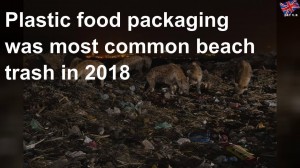From an Article by Laura Parker, National Geographic, September 3, 2019
A million volunteer-strong beach clean-up effort spanned 120 countries; it also turned up an artificial Christmas tree and a typewriter.
The garden vegetables remains crisp for three days at your local market. Wrap it in polyethylene shrink wrap and its longevity extends to 14. That, in short, explains the rapid growth of plastic food packaging, projected to become a $370 billion market next year.
With those numbers, it comes as little surprise that the way humans buy and consume food is having such a tangible impact on the oceans. Nine of the Ocean Conservancy’s top ten items retrieved from its annual beach cleanups are related to food and drink. Food packaging remains the second most common trash item collected during the group’s annual beach cleanup in 2018. And now for the first time, plastic forks, knives, and spoons have made the list, according to the group’s new report.
Aside from food packaging—more than 3.7 million individual wrappers were collected—the list of disposable plastics includes straws, stirrers, cutlery, bottles and caps, grocery bags and other plastic bags (for food and other uses), lids, cups, and plates.
The exception is cigarette butts, which contain plastic filters, and has remained the No. 1 item for many years. “Cigarette butts are a separate issue and they win the race every year,” says George Leonard, the Ocean Conservancy’s chief scientist.
“If you run down the rest of the top ten list, what strikes me is that the vast majority are not recyclable. To the extent we talk about recycling as a solution to ocean plastic problems, it would have to get to 50 or 90 percent, which is a huge lift and gets complicated very quickly,” he says.
The 2018 cleanup also drew more than a million people for the first time. They collected more than 23.3 million pounds of trash on beaches in more than 120 nations, and catalogued nearly a million separate items, creating a snapshot of nearly everything humans make and use.
The cleanup collection included more than 69,000 toys, more than 16,000 appliances, a chandelier, an artificial Christmas tree, a garage door, and a cash register.
The organization is conducting an extended analysis of data, looking for global patterns that could inform the effort to keep plastic trash out of the oceans, Leonard says.
What struck Leonard about the 2018 cleanup wasn’t the volume of items retrieved—more people on the beach collect more trash—but what the volume of people turning out to pick it up says about the issue of plastic pollution.
“Volunteerism is alive and well,” he says. “And the growing outrage about oceans is a real motivator.”
This year’s cleanup is scheduled for September 21.
National Geographic is committed to reducing plastics pollution. Learn more about our non-profit activities at natgeo.org/plastics. Learn what you can do to reduce your own single-use plastics, and take your pledge.
>>> Laura Parker is a staff writer who specializes in covering climate change and marine environments.

